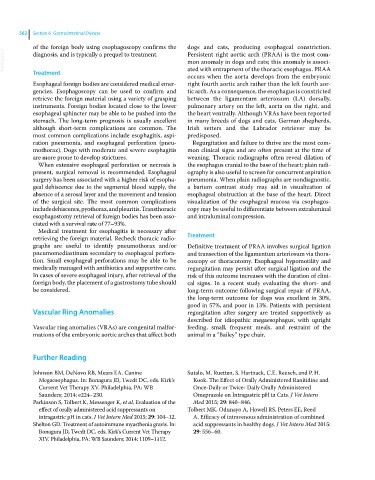Page 594 - Clinical Small Animal Internal Medicine
P. 594
562 Section 6 Gastrointestinal Disease
of the foreign body using esophagoscopy confirms the dogs and cats, producing esophageal constriction.
VetBooks.ir diagnosis, and is typically a prequel to treatment. Persistent right aortic arch (PRAA) is the most com-
mon anomaly in dogs and cats; this anomaly is associ-
ated with entrapment of the thoracic esophagus. PRAA
Treatment
occurs when the aorta develops from the embryonic
Esophageal foreign bodies are considered medical emer- right fourth aortic arch rather than the left fourth aor-
gencies. Esophagoscopy can be used to confirm and tic arch. As a consequence, the esophagus is constricted
retrieve the foreign material using a variety of grasping between the ligamentum arteriosum (LA) dorsally,
instruments. Foreign bodies located close to the lower pulmonary artery on the left, aorta on the right, and
esophageal sphincter may be able to be pushed into the the heart ventrally. Although VRAs have been reported
stomach. The long‐term prognosis is usually excellent in many breeds of dogs and cats, German shepherds,
although short‐term complications are common. The Irish setters and the Labrador retriever may be
most common complications include esophagitis, aspi- predisposed.
ration pneumonia, and esophageal perforation (pneu- Regurgitation and failure to thrive are the most com-
mothorax). Dogs with moderate and severe esophagitis mon clinical signs and are often present at the time of
are more prone to develop strictures. weaning. Thoracic radiographs often reveal dilation of
When extensive esophageal perforation or necrosis is the esophagus cranial to the base of the heart; plain radi-
present, surgical removal is recommended. Esophageal ography is also useful to screen for concurrent aspiration
surgery has been associated with a higher risk of esopha- pneumonia. When plain radiographs are nondiagnostic,
geal dehiscence due to the segmental blood supply, the a barium contrast study may aid in visualization of
absence of a serosal layer and the movement and tension esophageal obstruction at the base of the heart. Direct
of the surgical site. The most common complications visualization of the esophageal mucosa via esophagos-
include dehiscence, pyothorax, and pleuritis. Transthoracic copy may be useful to differentiate between extraluminal
esophagostomy retrieval of foreign bodies has been asso- and intraluminal compression.
ciated with a survival rate of 77–93%.
Medical treatment for esophagitis is necessary after
retrieving the foreign material. Recheck thoracic radio- Treatment
graphs are useful to identify pneumothorax and/or Definitive treatment of PRAA involves surgical ligation
pneumomediastinum secondary to esophageal perfora- and transection of the ligamentum arteriosum via thora-
tion. Small esophageal perforations may be able to be coscopy or thoracotomy. Esophageal hypomotility and
medically managed with antibiotics and supportive care. regurgitation may persist after surgical ligation and the
In cases of severe esophageal injury, after retrieval of the risk of this outcome increases with the duration of clini-
foreign body, the placement of a gastrostomy tube should cal signs. In a recent study evaluating the short‐ and
be considered. long‐term outcome following surgical repair of PRAA,
the long‐term outcome for dogs was excellent in 30%,
good in 57%, and poor in 13%. Patients with persistent
Vascular Ring Anomalies regurgitation after surgery are treated supportively as
described for idiopathic megaesophagus, with upright
Vascular ring anomalies (VRAs) are congenital malfor- feeding, small, frequent meals, and restraint of the
mations of the embryonic aortic arches that affect both animal in a “Bailey” type chair.
Further Reading
Johnson BM, DeNovo RB, Mears EA. Canine Sutalo, M. Ruetten, S. Hartnack, C.E. Reusch, and P. H.
Megaesophagus. In: Bonagura JD, Twedt DC, eds. Kirk’s Kook. The Effect of Orally Administered Ranitidine and
Current Vet Therapy XV. Philadelphia, PA: WB Once-Daily or Twice- Daily Orally Administered
Saunders; 2014: e224–230. Omeprazole on Intragastric pH in Cats. J Vet Intern
Parkinson S, Tolbert K, Messenger K, et al. Evaluation of the Med 2015; 29: 840–846.
effect of orally administered acid suppressants on Tolbert MK, Odunayo A, Howell RS, Peters EE, Reed
intragastric pH in cats. J Vet Intern Med 2015; 29: 104–12. A. Efficacy of intravenous administration of combined
Shelton GD. Treatment of autoimmune myasthenia gravis. In: acid suppressants in healthy dogs. J Vet Intern Med 2015:
Bonagura JD, Twedt DC, eds. Kirk’s Current Vet Therapy 29: 556–60.
XIV. Philadelphia, PA: WB Saunders; 2014: 1109–1112. 

